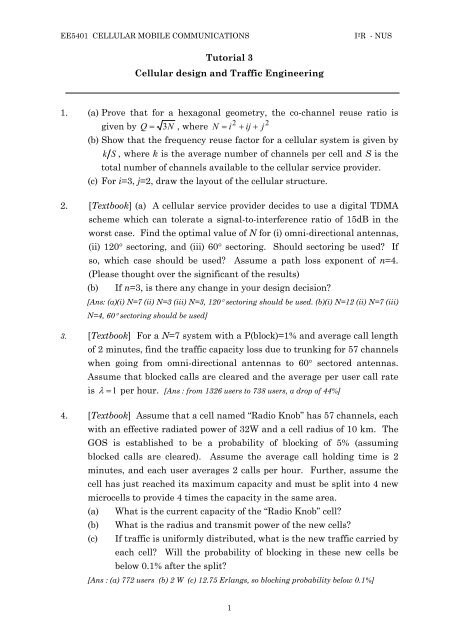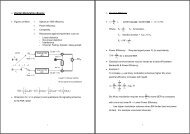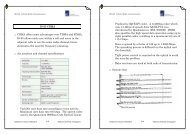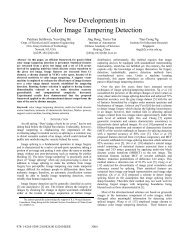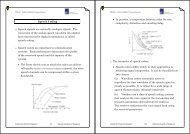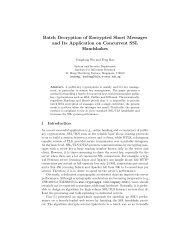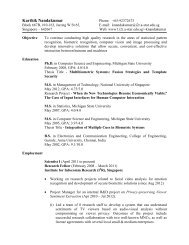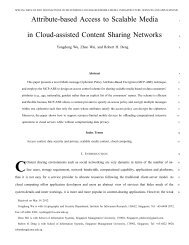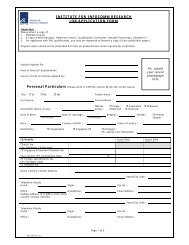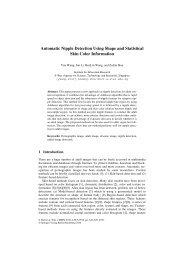Tutorial 3 Cellular design and Traffic Engineering 1. (a) Prove that ...
Tutorial 3 Cellular design and Traffic Engineering 1. (a) Prove that ...
Tutorial 3 Cellular design and Traffic Engineering 1. (a) Prove that ...
You also want an ePaper? Increase the reach of your titles
YUMPU automatically turns print PDFs into web optimized ePapers that Google loves.
EE5401 CELLULAR MOBILE COMMUNICATIONS<br />
I 2 R - NUS<br />
<strong>Tutorial</strong> 3<br />
<strong>Cellular</strong> <strong>design</strong> <strong>and</strong> <strong>Traffic</strong> <strong>Engineering</strong><br />
<strong>1.</strong> (a) <strong>Prove</strong> <strong>that</strong> for a hexagonal geometry, the co-channel reuse ratio is<br />
2 2<br />
given by Q = 3N<br />
, where N = i + ij + j<br />
(b) Show <strong>that</strong> the frequency reuse factor for a cellular system is given by<br />
k S , where k is the average number of channels per cell <strong>and</strong> S is the<br />
total number of channels available to the cellular service provider.<br />
(c) For i=3, j=2, draw the layout of the cellular structure.<br />
2. [Textbook] (a) A cellular service provider decides to use a digital TDMA<br />
scheme which can tolerate a signal-to-interference ratio of 15dB in the<br />
worst case. Find the optimal value of N for (i) omni-directional antennas,<br />
(ii) 120° sectoring, <strong>and</strong> (iii) 60° sectoring. Should sectoring be used? If<br />
so, which case should be used? Assume a path loss exponent of n=4.<br />
(Please thought over the significant of the results)<br />
(b) If n=3, is there any change in your <strong>design</strong> decision?<br />
[Ans: (a)(i) N=7 (ii) N=3 (iii) N=3, 120° sectoring should be used. (b)(i) N=12 (ii) N=7 (iii)<br />
N=4, 60° sectoring should be used]<br />
3. [Textbook] For a N=7 system with a P(block)=1% <strong>and</strong> average call length<br />
of 2 minutes, find the traffic capacity loss due to trunking for 57 channels<br />
when going from omni-directional antennas to 60° sectored antennas.<br />
Assume <strong>that</strong> blocked calls are cleared <strong>and</strong> the average per user call rate<br />
is λ = 1 per hour. [Ans : from 1326 users to 738 users, a drop of 44%]<br />
4. [Textbook] Assume <strong>that</strong> a cell named “Radio Knob” has 57 channels, each<br />
with an effective radiated power of 32W <strong>and</strong> a cell radius of 10 km. The<br />
GOS is established to be a probability of blocking of 5% (assuming<br />
blocked calls are cleared). Assume the average call holding time is 2<br />
minutes, <strong>and</strong> each user averages 2 calls per hour. Further, assume the<br />
cell has just reached its maximum capacity <strong>and</strong> must be split into 4 new<br />
microcells to provide 4 times the capacity in the same area.<br />
(a) What is the current capacity of the “Radio Knob” cell?<br />
(b) What is the radius <strong>and</strong> transmit power of the new cells?<br />
(c) If traffic is uniformly distributed, what is the new traffic carried by<br />
each cell? Will the probability of blocking in these new cells be<br />
below 0.1% after the split?<br />
[Ans : (a) 772 users (b) 2 W (c) 12.75 Erlangs, so blocking probability below 0.1%]<br />
1
EE5401 CELLULAR MOBILE COMMUNICATIONS<br />
I 2 R - NUS<br />
5. [Textbook] A receiver in an urban cellular radio system detects a 1 mW<br />
signal at d = d 0 = 1m from the transmitter. In order to mitigate cochannel<br />
interference effects, it is required <strong>that</strong> the signal received at any<br />
base station receiver from another base station transmitter which<br />
operates with the same channel must be below –100dBm. A<br />
measurement team has determined <strong>that</strong> the average path loss exponent<br />
in the system is n = 3. (a) Determine the major radius of each cell if a 7-<br />
cell reuse pattern is used. (b) What is the major radius if a 4-cell reuse<br />
pattern is used? [Ans: (a) >470.1 m (b) >62<strong>1.</strong>9 m]<br />
6. [96/97 Exam] Assume a 4-cell reuse pattern. A total of 96 channels are<br />
available for each cluster. In a specific cluster the traffic load is not<br />
uniformly distributed over the cells. To cater for the different<br />
requirements, the available channels are allocated as follows: {42, 30, 18,<br />
6} for the cells in the cluster.<br />
(a) Given a blocking probability of 2%, what traffic loads can each cell<br />
accommodate?<br />
(b) Due to interference problems, 120 degrees sectorisation is<br />
introduced into the system. What traffic loads can each cell now<br />
accommodate? Explain possible differences.<br />
(c) Assume <strong>that</strong> we can categorize the traffic patterns into 3 classes.<br />
Short message of duration 20sec/call, normal calls of duration 4<br />
min/call <strong>and</strong> teenage gossiping of duration <strong>1.</strong>5 hours/call. Let<br />
there be 5 normal calls <strong>and</strong> 10 short message for each teenager<br />
calling. How many calls per hour can be accommodated on<br />
average in the cluster when sectorisation is not used?<br />
[Ans: (a) 32.8, 2<strong>1.</strong>9, 1<strong>1.</strong>5, 2.28 Erlang (b) 24.6, 15.24, 6.84, 0.67 Erlang (c) 580 calls/hr]<br />
7. [96/97 Exam] Shadowing is experienced in each cell. The shadowing<br />
follows a log-normal distribution with a shadowing spread of 5 dB. The<br />
transmitted power is P t =10W, the cell radius of R=3km, the reference<br />
distance is d 0 =1km, <strong>and</strong> the carrier frequency is 900MHz. The<br />
environment is described by a path loss exponent of α = 3. 5 .<br />
(a) Assuming shadowing losses only, what is the probability <strong>that</strong> the<br />
received signal level is 3 times smaller than the average level?<br />
(b) Assuming <strong>that</strong> satisfactory performance is possible for a signal<br />
level above the threshold level γ = −63. 46 dBm, what is the<br />
coverage percentage at the boundary of the cell given shadowing?<br />
(c) If the transmit power is increased by a factor of 3, what cell size<br />
2
EE5401 CELLULAR MOBILE COMMUNICATIONS<br />
I 2 R - NUS<br />
should be used to maintain the same coverage at the boundary?<br />
[Hint : If no knowledge is given for d6.34 km]<br />
9. [Textbook] A PCS licenssee plans to build out a 30 MHz license in the<br />
new US PCS b<strong>and</strong> of 1850MHz to 1880MHz (reverse line) <strong>and</strong> 1930MHz<br />
to 1960 MHz (forward lind). They intend to use DCS1900 radio<br />
equipment. DCS1900 provides a GSM-like service <strong>and</strong> supports 8 users<br />
per 200kHz radio channel using TDMA. Because of GSM’s digital<br />
techniques, GSM vendors have convinced the licensee <strong>that</strong> when the path<br />
loss exponent is equal to 4, GSM can be deployed using 4-cell reuse.<br />
(a) How many GSM radio channels can be used by the licensee?<br />
(b) If each DCS1900 base station can support a maximum of 64 radio<br />
channels. How many users can be supported by the base station<br />
during fully loaded operation?<br />
3
EE5401 CELLULAR MOBILE COMMUNICATIONS<br />
I 2 R - NUS<br />
(c)<br />
(d)<br />
(e)<br />
(f)<br />
(g)<br />
(h)<br />
If the licensee wishes to cover a city having a circular shaped area<br />
of 2500 sq km, <strong>and</strong> the base stations use 20W transmitter powers<br />
<strong>and</strong> 10dB gain omni-directional antennas, determine the number<br />
of cells required to provide forward link coverage to all parts of the<br />
city. Assume 4-cell reuse, <strong>and</strong> let n=4 <strong>and</strong> the st<strong>and</strong>ard deviation<br />
of 8dB hold as the path loss model for each cell in the city. Also<br />
assume <strong>that</strong> a required signal level of –90dBm must be provided<br />
for 93% of the coverage area in each cell, <strong>and</strong> <strong>that</strong> each mobile uses<br />
a 0dB gain antenna. Assume d 0 =1km.<br />
For your answer in (c), define in exact detail a suitable channel<br />
reuse scheme for each cell in the city, <strong>and</strong> define the channels used<br />
by each cell. Your scheme should include details such as how<br />
many channels each base station should use, what the nearest<br />
reuse distance should be, <strong>and</strong> other issues which clearly define<br />
how to assign channels geographically throughout the city? You<br />
may assume <strong>that</strong> users are distributed uniformly throughout the<br />
city, <strong>that</strong> each cell is equal distance from its neighbors, <strong>and</strong> you<br />
may ignore the effect of control channels (<strong>that</strong> is, assume all radio<br />
channels carry only voice users).<br />
How many (I) cells (base stations) (ii) total radio channels (iii)<br />
total user channels (there are 8 user channels per radio channel)<br />
are available throughout the entire city, based on your answer in<br />
(d)? The total number of user channels is equal to the maximum<br />
capacity of the system <strong>and</strong> is a hard limit on the number of users<br />
<strong>that</strong> can be simultaneously served at full capacity.<br />
If each base station costs $500,000, <strong>and</strong> each radio channel within<br />
the base station costs $50,000, what is the cost of the system in (e)?<br />
This is the initial cost of the system.<br />
If the system in (d) is <strong>design</strong>ed for 5% blocking probability at startup,<br />
what is the maximum number of subscribers <strong>that</strong> can be<br />
supported at start-up? This is the number of phones <strong>that</strong> may be<br />
initially subscribed at start-up. Assume <strong>that</strong> each user channel is<br />
trunked along with the other user channels on other radio<br />
channels within the base station.<br />
Using your answer in (g), what is the average cost per user needed<br />
to recoup 10% of the initial system buildout cost after one year if<br />
the number of subscribers is static during year 1?<br />
[Ans : (a) 150 (b) 512 (c) 10 (d) Cluster size = 4, 38, 38, 37, 37 (e) 10, 375, 3000 (f)<br />
$23.75x10**6 (g) 3x10**4 (h) $79.17]<br />
4
EE5401 CELLULAR MOBILE COMMUNICATIONS<br />
I 2 R - NUS<br />
10. [Textbook, Jon Mark] .Consider a cellular system in which there are a<br />
total of 1001 radio channels available for h<strong>and</strong>ling traffic. Suppose the<br />
area of a cell is 6 km 2 <strong>and</strong> the area of the entire system is 2100 km 2 .<br />
(a) Calculate the system capacity if the cluster size is 7<br />
(b) How many times would the cluster of size 4 have to be replicated in<br />
order to approximately cover the entire cellular area?<br />
(c) Calculate the system capacity if the cluster size is 4.<br />
(d) Does decreasing the cluster size increase the system capacity?<br />
Explain.<br />
Consider the case when cell cluster of size 7. Given <strong>that</strong> the traffic load<br />
per user is 0.03 Erlangs <strong>and</strong> the average number of calls per hour per<br />
user is <strong>1.</strong>5, for an Erlang-C system with a probability of delaying a call<br />
being 5%, determine<br />
(e) The traffic load per cell<br />
(f) The number of users per km 2 <strong>that</strong> can be supported by this system<br />
(g) The mean duration of a call<br />
(h) The probability <strong>that</strong> a delayed call will have to wait for more than<br />
10s, <strong>and</strong><br />
(i) The probability <strong>that</strong> a call will be delayed for more than 10s.<br />
[Ans : (a) 50,050 (b) ≈ 87 (c) 87,000 (d) yes (e) 122.98 Erlangs (f) 683 (g) 72s (h) 0.062<br />
(i) 0.0031]<br />
5


